
Federal immigration officials often rely on local law enforcement to identify people who may be in violation of immigration laws. But some jurisdictions would refuse to turn over suspected undocumented immigrants to the Immigration and Customs Enforcement. The process goes as follows. Police arrest immigrants for reasons unrelated to their immigration status and are booked in local jails. There, their fingerprints are taken and eventually shared with Immigration and Customs Enforcement which is required by law. ICE will ask officials to hold individuals if they’re in violation of immigration laws while ICE obtains a warrant. County and municipal policies dictate whether to comply, or release the individuals in question. Depending on local criteria, a sanctuary jurisdiction wouldn’t comply.
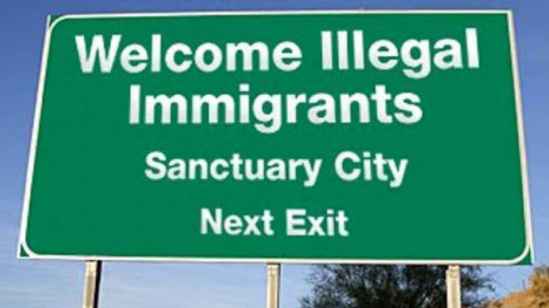
Sanctuary cities have been a major topic in recent years and are mainly believed to be liberal metropolises that are riddled with crime. Conservatives often argue in favor of defunding them and they aren’t seen as popular. However, sanctuary communities have been on the rise and not for the reasons conservatives think.
In recent times, the topic of sanctuary cities has attracted a lot of attention since undocumented immigration is a very controversial subject almost everyone has an opinion about. And this issue has been pushed by Republicans who call sanctuary cities as a crime ridden hellholes that should be defunded in order to get with the program. Congressional Republicans have introduced bills targeting these places, while Republican governors and state legislators have enacted policies banning them. Either way, Republican politicians have campaigned against sanctuary cities during the 2016 election. And now newly President Cheeto Pussygrabber has signed an executive order directing the Attorney General and the Secretary of Homeland Security to defund sanctuary jurisdictions refusing to comply with federal immigration law. Also, he issued the Department of Homeland Security to begin issuing public reports including, “a comprehensive list of criminal actions committed by aliens and any jurisdiction that ignored or otherwise failed to honor any detainers with respect to such aliens.” However, a George Mason law professor argued that Mr. Raging Orange Rug Hair’s withholding of federal funding to these places would be unconstitutional: “Trump and future presidents could use [the executive order] to seriously undermine constitutional federalism by forcing dissenting cities and states to obey presidential dictates, even without authorization from Congress. The circumvention of Congress makes the order a threat to separation of powers, as well.” Nevertheless, sanctuary communities have been on the rise, especially in my home state of Pennsylvania where they now consist of half the state. And it’s likely that Pittsburgh may be on its way. Though that hasn’t stopped the State House from passing an anti-sanctuary bill mandating that these counties and municipalities honor ICE requests to hold a person in custody for at least 48 hours or else no state grants for law enforcement.
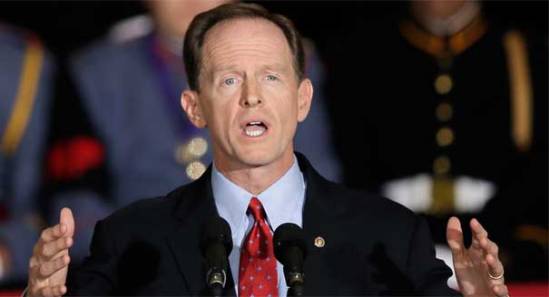
Here is Senator Pat Toomey of Pennsylvania. In 2016, he distinguished himself as a high profile opponent of sanctuary cities and has proposed to defund these criminal hellholes. But in a sick twist of irony, one of these would be his home county of Lehigh which became the setting for a major case that made sanctuary communities much more popular in Pennsylvania.
So what are sanctuary cities? Are they really as horrible as they say? And why have they been on the rise in recent years? You might think these policies are designed to protect undocumented immigrants. But the reality is far more complicated than what most people even imagine. And they’re often so misunderstood. Perhaps I can show you an FAQ to answer your questions.
What is a sanctuary city?

When people think about sanctuary cities, they often think of San Francisco. However, sanctuary cities is kind of misnomer since sanctuary polices have been adopted by states as well as all kinds of municipalities. Sometimes this is through written policy while other times it’s through certain practices. These policies and practices differ throughout jurisdictions. However, just to be convenient we’re just going to define sanctuary jurisdictions as places who refuse to honor ICE detainers by themselves for whatever reason.
A sanctuary city is a jurisdiction that’s adopted a policy protecting undocumented immigrants by not prosecuting them for violating federal immigration laws in the country in which they’re now living. Such policy can be set out expressly in law (as in local ordinance) or observed only in practice (like a don’t ask, don’t tell policy). It generally applies to cities that don’t use municipal funds or resources to enforce nationally immigration laws and usually forbid police or municipal employees to inquire about a person’s immigration status. The designation has no precise legal meaning. Policies and practices differ throughout the country.
How many sanctuary cities are there?

This map is from a study at Temple University in Philadelphia. It shows how each county in the state deals with ICE detainer requests. I should also like to point out that many of these sanctuary counties don’t like to be viewed as such and went for Trump in 2016. And they’re certainly not the places you think of when we talk about sanctuary cities.
According to the Immigrant Legal Resource Center, sanctuary policies limiting how much local police can cooperate with requests from federal authorities to hold immigrants in detention are present in 4 states, 39 cities, and 364 counties. These include almost every county in Colorado, Oregon, and New York as well as most of Florida as well as California, Vermont, Rhode Island and Connecticut, and several major cities on the East Coast. And they’re not just limited to liberal and urban areas either. For instance, if you look at a map of Pennsylvania from a study at Temple, you’d notice that there are sanctuary policies in my home jurisdiction of Westmoreland County as well as in Fayette, Washington, Somerset, Armstrong, Butler, Clarion, Erie, Blair, and Bedford as of 2017. And the ones I just described have only had sanctuary policies in their books since September. All of these counties went for Trump in 2016 and probably would rather see the undocumented living among them deported. Which is why local officials try to distance themselves from the loaded “sanctuary” label.
Are sanctuary cities legal?
It’s hard to say. The Illegal Immigration Reform and Immigrant Responsibility Act of 1996 has outlawed cities’ bans against municipal workers’ reporting people’s immigration status to federal authorities as well as established minor crimes as grounds for deportation. Its Section 287(g) allows state and local law enforcement personnel to enter into agreements with the federal government to be trained in immigration enforcement that would help them enforce immigration law. But it provides no general power for immigration enforcement by state and local authorities. However, such provision was only implemented by state and local authorities in California, Arizona, Alabama, Florida, and North Carolina as of 2006. Furthermore, 8 U.S. Code § 1373 states that “a Federal, State, or local government entity or official may not prohibit, or in any way restrict, any government entity or official from sending to, or receiving from, the Immigration and Naturalization Service information regarding the citizenship or immigration status, lawful or unlawful, of any individual.” Opponents state that the Justice Department requires that most federal grant money recipients certify their compliance to federal law, which sanctuary cities violate by not asking about, recording, or submitting their residents’ immigration status to the feds.
However, though federal officials usually have to rely on local police to help enforce federal immigration laws, the law doesn’t necessarily require local authorities to detain undocumented immigrants because their federal counterparts make a request. In fact, federal courts across the country have found complying with requests is usually voluntary. To back it up, supporters often cite the Tenth Amendment that according the Immigrant Legal Resource Center, prevents the, “federal government from coercing state or local governments to use their resources to enforce a federal regulatory program, like immigration.” Thus, Congress can’t force state or local governments to collect immigrant status information in order to share it with the Feds. And because these places never collected the data in the first place, they didn’t violate federal law. Some even believe enforcing immigration should only be left to the federal government and that local law enforcement should stay out of it. So let’s just say it’s a legal tossup at the moment.
Are sanctuary cities a new thing?

Sanctuary cities have been in California for years thanks to the Sanctuary Movement. However, while many think that California metro areas adopt these policies due to liberal leanings, we also have to account for the fact that undocumented immigrants play a key role in the state’s economy and society, especially in low-income jobs. Not to mention, past instances have led authorities focus more on building relationships with immigrant communities in order to solve crimes. In other words, local law enforcement needs undocumented immigrants to be able to contact them without fear of deportation.
No. Los Angeles was the first to initiate a sanctuary city policy in 1979 to prevent police from inquiring about arrestees’ immigration status. The internal “Special Order 40” states: “Officers shall not initiate police action with the objective of discovering the alien status of a person. Officers shall not arrest nor book persons for violation of title 8, section 1325 of the United States Immigration code (Illegal Entry).” Certain other cities have followed suit during the 1980s and after. Though recent years have also contributing other jurisdictions to the same.
So when did sanctuary cities become a national issue?
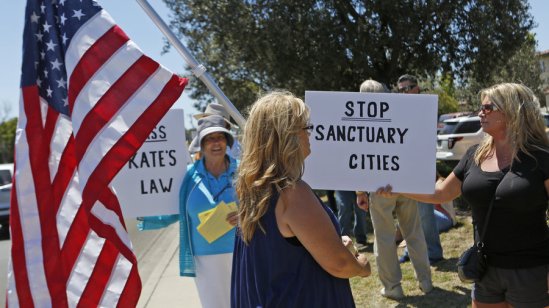
Sanctuary cities have become more of a high profile issue in recent years due to their reputation of harboring undocumented immigrants. And much of it has been opposition by Republicans who have no idea why jurisdictions would implement these policies in the first place. This especially apparent with Pat Toomey who opposes sanctuary polices while his home Lehigh County has adopted them. And for a very good reason.
The issue entered in the national spotlight with the 2008 GOP presidential primary when Colorado Representative Tom Tancredo ran on an anti-illegal immigration platform and specifically attacked sanctuary cities. Former Massachusetts governor Mitt Romney also accused former mayor Rudy Giuliani of running New York City as one. Giuliani’s campaign returned the favor saying that Romney ran a sanctuary in the Governor’s mansion and that New York City isn’t a “haven” for undocumented immigrants.
Then there were reports of a series of crimes. In late June 2009, 3 undocumented immigrants were suspected of murdering a waitress in Albuquerque, New Mexico (one of whom was not deported despite being arrested for two prior DUI incidents). Then mayoral candidate Richard J. Berry decried the city’s sanctuary policy and vowed to eliminate it if elected. He defeated incumbent Mayor Martin Chavez that year.

Kathryn Steinle’s murder by an undocumented immigrant Juan Francisco Lopez-Sanchez in 2015 had sparked a national debate about sanctuary cities. And it led to a piece of congressional legislation known as “Kate’s Law” which targeted undocumented immigrants with criminal records and multiple deportations. But as of 2017, no vote has been held.
In 2015, an undocumented immigrant with multiple deportations shot Kathryn Steinle dead in San Francisco which sparked controversy and political debate over its place as a sanctuary city. In addition, many Republican presidential candidates would blame the sanctuary city policy for Steinle’s murder and encourage the need for a secure border wall. Donald Trump would also use the incident to criticize Jeb Bush and as a rationale to deport undocumented immigrants in the US.
Meanwhile, Congress would author The Establishing Mandatory Minimums for Illegal Reentry Act of 2015 or Kate’s Law which would’ve amended the Immigration and Nationality Act to increase from two years to five years the maximum prison term for an alien who reenters after being denied admission, excluded, deported, or removed. It also would’ve established a 10-year maximum prison sentence for an alien reentering after being denied admission, excluded, deported, or removed on 3 or more prior occasions and 5-year mandatory minimum prison term for an alien who reenters after being removed following a conviction for an aggravated felony or following 2 or more prior convictions for illegal reentry.
Do sanctuary cities increase crime?
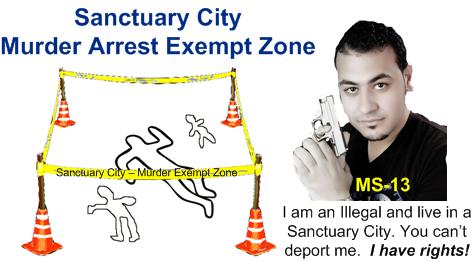
Despite that conservatives have pointed out how sanctuary policies contribute to more crime, there is absolutely no evidence supporting that argument. However, there is evidence that might suggest that sanctuary policies might do the opposite.
According to a study by University of California at Riverside assistant professor Loren Collingwood, sanctuary policies don’t have any statistically meaningful effect on crime.
A study by associate professor Tommy K. Wong of the University of California, San Diego draws a different conclusion. “Crime is statistically significantly lower in sanctuary counties compared to nonsanctuary counties,” he wrote in a paper for the Center of American Progress. “Moreover, economies are stronger in sanctuary counties—from higher median household income, less poverty, and less reliance on public assistance to higher labor force participation, higher employment-to-population ratios, and lower unemployment.” The study evaluated sanctuary and non-sanctuary cities, “while controlling for differences in population, the foreign-born percentage of the population, and the percentage of the population that is Latino.”
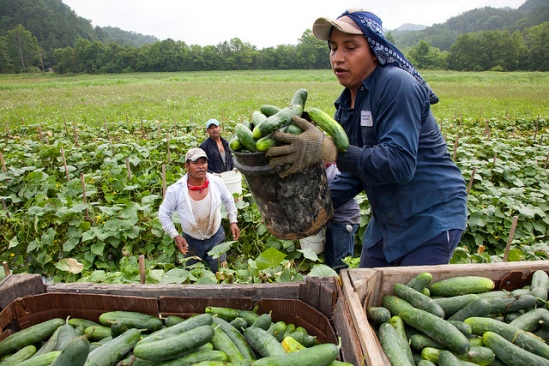
Local law enforcement in sanctuary jurisdictions often admit that they rely on undocumented immigrants to come forward and report crimes. The fact undocumented immigrants are more likely to be crime victims than anyone else and more afraid to contact the police shows why.
We should also account that local law enforcement officials favor sanctuary policies and have said they don’t want the job of enforcing federal immigration laws. In addition, they admit to relying on immigrants in their communities to come forward to report crimes. The fact undocumented immigrants are most likely to be crime victims and least likely to report crimes to the police illustrates why many police view sanctuary cities this way. Undocumented immigrants who don’t live in sanctuary jurisdictions are frequently discouraged from reporting crimes to police due to fears of deportation. And these deportation fears can limit law enforcement access to potential victims, witnesses, informants, and neighborhood advocates. Many police often say that honoring ICE detainer requirements could scare people away and don’t want law-abiding undocumented immigrants to be afraid to contact them in order to report a crime.
Do sanctuary city policies prevent police from cooperating with federal immigration authorities?
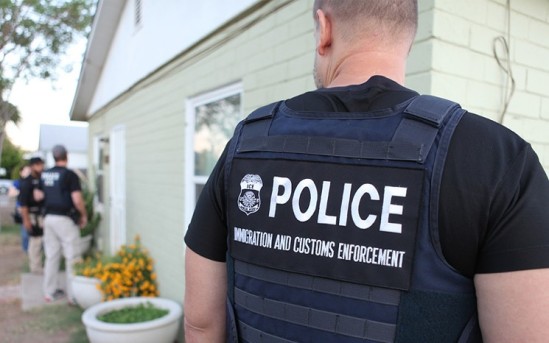
Contrary to popular belief, while sanctuary policies may restrict police from cooperating with federal authorities, they don’t prevent it entirely. Most of the time, sanctuary policies restrict ICE cooperation with law enforcement on certain criteria. For instance, a sanctuary jurisdiction may refuse to honor ICE detainer requests because the individual warrant out against them or a criminal record to speak of. Or that the detainer isn’t backed up by a warrant from a judge.
Most sanctuary policies only limit police from cooperating with federal immigration authorities on undocumented immigrants with no criminal record to speak of. Let’s just say every jurisdiction is different but most of the time sanctuary policies specify that local authorities can’t hand over undocumented immigrants to ICE solely due to their immigration status, on minor crimes, or without any judicial warrant or court order. None of these protective policies prevent police from pursuing immigrants who commit felonies. According to a Department of Justice inspector general report, some jails in sanctuary areas only comply with a detainer request when the inmate has prior felony convictions, gang membership, or is on a terrorist watchlist. Others may reject every detainer request as well as refuse any kind of collaboration with ICE. In my home Westmoreland County, Pennsylvania, county prison staff don’t accept ICE detainers unless they have a judicially authorized warrant or court order. Otherwise, the ICE detainer will be sent back to the agent. But while Westmoreland County said they’d inform ICE if a suspected undocumented immigrant is being released, most cooperation ends here. Washington County does the same thing as well as put the detainers on file for future reference. Meanwhile, Butler County’s sanctuary policy expressly forbids ICE agents from accessing the county jail or those in custody for investigative purpose. Butler also prohibits officials from using county resources to communicate with ICE regarding inmates. So whether sanctuary policies prevent local police from cooperating with ICE varies from jurisdiction.
Why would any place want to adopt sanctuary policies?

If you want to understand why jurisdictions would adopt sanctuary policies, we should understand the Secure Communities program which was supposed to encourage federal, state, and local cooperation on deporting criminal undocumented immigrants. However, the Secure Communities program was riddled with problems, had unclear constitutionality, and resulted in incidents of abuse.
During the height of the country’s undocumented immigration challenges before the recession, law enforcement officials in some communities expressed concerns about releasing these inmates after they’ve serve time for state offenses. Some of these communities entered agreements to help federal authorities with immigration enforcement. These arrangements allowed local jails to house undocumented immigrants after they served time on state charges and bill the federal government for this service. Sometimes they passed these inmates to jails without any formal notice to family members, then into the immigration court system for an expedited removal hearing. A lot of times, people were returned to their home countries in weeks. By 2011, the Secure Communities program had been deporting more than 400,000 people per year and had over 1,210 jurisdictions participating.

The Secure Communities program was often criticized for many of its inherent flaws such has lack of recognition of civil rights and due process as well as lack of transparency and oversight. Studies showed that most of the arrestees who were deported didn’t have any serious criminal record to speak of. There may be constitutional issues as well.
Critics often said the Secure Communities Program could generate a revenue stream for local prisons as well as violate international human rights accords. Many localities and states reported not being reimbursed for costs relating to their participation and saw the program as a strain on their resources. Civil liberties organizations called it a vehicle for cultural profiling. Some people couldn’t talk to their embassy officials from their countries or notify family members of their arrests, basically disappearing without explanation.More than one analysis of deportees and what happened during the process showed that most of these people were initially arrested for minor traffic violations, had no criminal records to speak of, or were low-level offenders who served their time. A 2011, Berkeley study showed that only 52% of Secure Communities arrestees were scheduled to have a hearing before a judge and out of those who had, only 24% were represented by an attorney. They also found that 88,000 families that included US citizens had a relative arrested under the program and that 3,600 of arrestees were US citizens. Immigrant advocates said the program deeply damaged already limited police trust in immigrant communities, making people afraid to call the cops or provide information, which these advocates saw as a threat to public safety. Thus, making these places harder to police. Also a number of court cases implied that the “detainer requests” might be unconstitutional and put cities in violation of the Fourth Amendment. Then there are have been reports that the Secure Communities program didn’t have clear complaint mechanisms as well as a lack of transparency and oversight.

Ernesto Galarza was a part-time construction worker who was illegally held at the Lehigh County jail for 3 days pursuant of an ICE detainer without a warrant, court order, or an explanation. And the ICE detainer was issued because Allentown police suspected Galarza may be an undocumented immigrant. Even though he carried a state driver’s license and his Social Security card as well as told police he was born in Perth Amboy, New Jersey. His case sent a broad message that if local jurisdictions choose to honor ICE detainer requests, they’ll have to face the consequences if it’s against the wrong people. Such ruling has been a driving force for jurisdictions across Pennsylvania adopting sanctuary policies.
Then there’s the matter with ICE issuing detainer requests they use to gain custody of undocumented immigrants for deportation. Detainer requests aren’t supported by a finding of probable cause or court order. In other words, it’s someone could have an ICE detainer on them on mere suspicion of an undocumented immigration status which can result in being detained for more than 48 hours. So it’s no surprise that some legal experts have questioned these ICE detainers’ constitutionality. In November 2008, Allentown police arrested a part-time construction worker named Ernesto Galarza in a drug bust at his workplace on a drug offense of which he was found innocent. At the time of his arrest, Galarza showed his state driver’s license and Social Security Card from his wallet and told local officials he was born in Perth Amboy, New Jersey, which should’ve made his US citizenship obvious to law enforcement. However, because Galarza was Hispanic, the arresting officer was apparently unsure about his citizenship and called ICE. ICE issued a detainer asking prison officials to hold Galarza while ICE investigated his citizenship and immigration status. As a result, Galarza was illegally held in the Lehigh County Prison for 3 days past when he should’ve been released with no warrant, no court order, and no explanation. And it was all because of racial profiling among local law enforcement as well as ICE agents’ baseless assertion that he might be an undocumented immigrant from the Dominican Republic they were looking for. Galarza lost his part-time job because of this. In March 2014, the U.S. Third Circuit Court of Appeals in Philadelphia found Lehigh County violated Galarza’s constitutional rights. Furthermore, the court ruled his detainer was only a request for help, not a binding order such as a federal warrant signed by a magistrate and that local governments have to pay damages for violating the rights of criminal suspects and jail inmates, not ICE. In other words, because Lehigh chose to honor the ICE detainer which resulted in a citizen’s wrongful imprisonment, it’s on them. After having to pay Galarza $95,000 in damages and attorney’s fees, the Lehigh County commissioners voted unanimously not to imprison people solely on ICE detainers against them. Other Pennsylvania counties followed suit figuring that it was safer to break federal immigration law than accidentally violate a citizen’s civil rights. Because if a local cop can get an ICE detainer against someone on merely suspecting their legal status, then it’s the federal immigration policy with the problem.
Do undocumented immigrants commit more crime than others?
To put it this way, absolutely not. Immigrants of all kinds are actually much less likely to commit crimes than native born citizens regardless of legal status. Not only that, the possibility of deportation usually gives immigrants a high incentive to obey the law. However, undocumented immigrants are far more likely to be crime victims because they’re least likely to report to the police due to threats of deportation. Now there may be some undocumented immigrants who are criminals, but the count’s not as high as 2-3 million. DHS estimates about 1.9 million while the Migration Policy Institute and Pew Research Center approximates 820,000 with some already incarcerated. Still, we should understand that undocumented crime is far less of a problem in localities than undocumented immigrants shunning contact with the police.
What about the shooting of Kathryn Steinle?
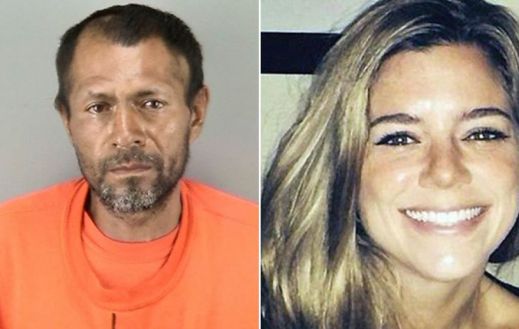
The murder of Kathyrn Steinle is often used as a talking point for cracking down on sanctuary cities. Is San Francisco’s sanctuary policy at fault? To an extent. But despite being deported 5 times, Juan Lopez-Sanchez was a low-level drug offender who served his time. So prior to shooting Steinle with a stolen gun, there was very little reason he’d pose a danger upon his release.
I know this story is often used by sanctuary city opponents on how San Francisco’s refusal to honor a detainer for Juan Lopez-Sanchez requesting that they keep him until ICE agents arrived cost a young woman’s life. Sure Lopez-Sanchez was a convicted felon who’ve been deported 5 times. However, there’s a lot that’s misunderstood about this case. For one, Lopez-Sanchez wasn’t a violent criminal and his record mostly consisted of reentry violations and drug offense all of which he served time on. The only real danger he posed to society was endangering those who bought drugs from him. So at best he was a low-level offender who served his time. Also, multiple deportations aren’t unusual for undocumented immigrants even for those without criminal records. Not to mention, Lopez-Sanchez had been homeless since his release. Second, the reason San Francisco didn’t honor ICE’s request was because Lopez-Sanchez had no active warrant for his arrest upon his release as consistent with their sanctuary city policy upon his release from prison. Yet, while the sheriff’s failure to notify ICE about Lopez-Sanchez’s release may have cost Steinle’s life since he had no active arrest warrant, it doesn’t mean that San Francisco’s sanctuary city policy is solely at fault. And if it is, it could be easily remedied with placing rules requiring law enforcement to notify ICE on individuals with criminal history upon their release. Other sanctuary jurisdictions do that. Third, it’s very likely that Steinle’s death was an accident because Lopez-Sanchez had absolutely no idea who she was. And it’s very unlikely that he fired that stolen gun in order to kill her because he might’ve fired toward the ground before the bullet ricocheted from the pavement. Fourth, it’s very likely Steinle’s death was due to failures at the local, state, and federal levels. Sure San Francisco’s sanctuary policy may be partly to blame. Yet, the Bureau of Prisons could’ve also handed Lopez-Sanchez to ICE instead of San Francisco. Hell, they could’ve just turned him over to a California state penitentiary. Or pass laws requiring people to lock their guns before leaving them in a car. Or maybe put Lopez-Sanchez in a halfway house so he wouldn’t be shooting a gun in the street.

The fact Lopez-Sanchez is an undocumented immigrant is only reason why Steinle’s death has generated such political outcry. However, had Lopez-Sanchez been a native-born US citizen, Steinle’s death would’ve been just as senseless and tragic. But nobody would blame it on San Francisco’s sanctuary city policy or that he should’ve been deported.
However, we should also note that prisons release crooks who go on to commit violent crimes all the time even for drug offenses like Lopez-Sanchez. Usually nobody says that such crimes could’ve been prevented had they been deported. Because most of these criminals were born in the United States. I’m sure the Bureau of Prisons has handed over US-born criminals to San Francisco authorities all the time as well as for crimes Lopez-Sanchez was charged with. It’s probably not unusual that San Francisco releases US-born prisoners without active warrants against them after they serve their time. And I’m certain it’s not unheard of for a US-born ex-con with a record like Lopez-Sanchez to kill someone shortly afterwards. Does any of that lead us to doubt whether our criminal justice system is too lenient? Sometimes. Yet, if Lopez-Sanchez was a native-born US citizen, would any politician blame San Francisco’s sanctuary policy and failure to deport him for Steinle’s death? No. Would Steinle’s murder have gotten the kind of attention it received? No. Because Lopez-Sanchez’s status as an undocumented immigrant is the sole reason why Steinle’s murder is so often used by immigration opponents to illustrate how sanctuary cities threaten public safety. But if Lopez-Sanchez wasn’t undocumented, he still would’ve posed just as much of a danger as any other violent criminal. And Steinle’s death would’ve been just as senseless and tragic even if covered just like any other murder case.
Why support sanctuary cities?

Sanctuary jurisdictions have many reasons to implement the kind of policies they do. Sometimes it’s because undocumented immigrants contribute so much to their society. Sometimes it could be that police would rather build relationships with immigrant communities and solve crimes than enforce immigration law. And sometimes it might be due to the area having limited resources and bigger priorities, having bad experiences with ICE, and a desire to avoid legal entanglements.
Other than basic human decency and keeping families together, supporters argue that cities have bigger priorities and too few resources to handle immigration enforcement. Many local policymakers and law enforcement agencies say that immigration enforcement isn’t their responsibility and that cracking down on undocumented residents disrupts community relations and make it more difficult to do their jobs. Cops prefer to focus on routine incidents in their localities than check whether a suspect, victim, or witness is legally on US soil. Yet, supporters note that none of their protective policies in any way prevent local police from pursuing immigrants suspected of committing crimes. In places like California, it might also be due to the vital role undocumented immigrants play in its economy and society as well as their large Latino population. You can say the same for many major cities as well as areas of Colorado and Florida. Then there’s the fact a lot of these places have endured a lot of bad experiences when they did cooperate with ICE, particularly during the Secure Communities program. For the recent rise in sanctuary counties in Pennsylvania, it has less to do with favoring undocumented immigration and more to do with avoiding expensive litigation, having limited jail space, not getting paid honoring ICE detainers, and others. Because honoring ICE detainers and racial profiling in local law enforcement have led to US citizens being illegally detained as illustrated in the Galarza case in Senator Pat Toomey’s home in Lehigh County. And since detainer requests aren’t binding orders, these local governments are usually stuck with paying the most in damages over civil rights violations, which Lehigh didn’t want to repeat. In the case of Armstrong County, the federal government didn’t reimburse their costs at the desired rate when they did hold people for ICE as well as having a jail typically operating at capacity.
Why oppose sanctuary cities?

Opponents on sanctuary policies often argue that they undermine federal enforcement efforts and compromising public safety that leads to preventable crimes. But opponents often stereotype sanctuary jurisdictions as places that are riddled with crime and lawlessness. Rather than a place that might be similar to where they live.
Opponents argue that sanctuary policies encourage undocumented immigration, undermine federal enforcement efforts, and severely compromise public safety resulting in crimes that could’ve been avoided through deportation. Furthermore, they believe that sanctuary policies keep police from investigating, questioning, and arresting people who’ve broken federal immigration law.
Is there a moral basis for sanctuary cities?

Though the legal basis of sanctuary policies may be in limbo, the moral basis is very much sound. I mean it should be a no brainer to keep families together as well as relieve law-abiding residents of deportation fears. Besides, sanctuary policies might be the best morally solution available at the moment.
Though the legal question of sanctuary cities can be debated, the moral question may not be the case. From what I know about undocumented immigrants, most of them came to this country illegal because the federal immigration system didn’t give them any legally viable options. Most of them have been in the US for at least 10 years while some came as children who grew up calling this country home. Many children who are US citizens and even American spouses. And despite entering illegally, most undocumented immigrants hold jobs, pay taxes, obey most of the laws, celebrate national holidays, and make contributions to society in ways most Americans don’t recognize. Furthermore, most undocumented immigrants come to the US for a better life than the one they left behind, not to commit crimes that endanger public safety. The fact federal immigration policy subjects their very presence as grounds for deportation has resulted in communities wary of law enforcement, thousands of broken families, and hundreds of kids in foster homes. And there is no good way for them to gain legal status or even citizenship. Ignoring an unjust federal immigration policy by providing a safe haven for these people may not be legal, but it’s probably the best moral solution available. But since President Cheeto Fuzz assumed office, you can forget the prospect of much needed comprehensive immigration reform for the next 4-8 years because that’s just not going to happen. In addition, the fact someone could get an ICE detainer against them because a police officer suspects their legal status has led to incidents of racial profiling and illegally holding American citizens in jail for over 48 hours with no warrant, no court order, and no explanation. In that case, refusing to hold individuals solely on an ICE detainer is morally reasonable. Then there’s the matter that municipalities don’t have the resources to handle immigration enforcement as well as bigger things to worry about. Local police would rather catch criminals than crack down on otherwise law-abiding residents who could help them. To cooperate with ICE may not be in their best interests and may lead local authorities to neglect their civic responsibilities to their constituents. So yes, enacting a sanctuary policy is probably the right thing to do.
Should sanctuary cities be punished for not complying with federal immigration policy?

If you think sanctuary cities should be defunded because they’re crime ridden areas sheltering undocumented immigrants, you might want to check if you live in one and why. If you live in Westmoreland County, Pennsylvania, you should really reconsider because it’s a sanctuary county. I swear I didn’t make this up. Look it up.
No. Despite that sanctuary policies may or may not go against federal law, I don’t think penalizing them is a good idea. Now I do believe that states and localities should adhere to federal law in most cases, especially when it comes to policies involving healthcare, education, civil rights, environmental protection, labor standards, product standards, gun laws, and financial regulation. In many cases, I find that a lot of state and local governments don’t serve their constituents’ best interests, especially when it concerns women, minorities, and the poor. But I do make exceptions when I think federal policy may not be unjust, inadequate, and prone to a lot of abuse particularly when it comes to national policy dealing with undocumented immigrants. The fact states and localities have developed their own policies to dealing with ICE and undocumented immigrants illustrates how federal immigration policy badly needs reform which won’t happen anytime soon. States and localities instituting sanctuary policies have very good reasons to enact them. They may not always be about protecting undocumented immigrants living among them, especially since it’s not just liberal cities adopting these policies. Or in jurisdictions where sanctuary policies would have widespread support like in rural and suburban Pennsylvania.Thus, penalizing sanctuary jurisdictions won’t be a very good idea in any case because they’re clearly not the problem. Sanctuary policies are more like a flawed and necessary substitute to work around a broken immigration system that needed to be fixed a long time ago but hasn’t. The best deterrence would be to pass comprehensive immigration reform which opens a path to citizenship for undocumented immigrants as well as requiring ICE detainers be issued with warrants and court orders. Now that I think about it, perhaps instead of punishing sanctuary jurisdictions, maybe our politicians should spend time in them and learn about their policies and why they enact them. And perhaps put those policies into congressional legislation. We can start by making US Senator Pat Toomey spend his congressional recess at his Allentown home for he really needs to know why Lehigh County enacted the kind of sanctuary policy he’s so vigorously opposed as well as a lesson on Galarza v. Szalczyk. Nevertheless, if the US government can’t come up with a federal immigration policy this nation needs, then expect more state and local governments enacting their own ideas to make the best of a sticky situation.

I end this post by bringing you a picture of the red covered bridge near where I live in the sanctuary jurisdiction of Westmoreland County, Pennsylvania. Let it be known that sanctuary policies aren’t just limited to liberal urban enclaves like San Francisco. They can also exist in rural areas like this that don’t have a lot of liberals in them. Or a lot of people supporting sanctuary policies either. You can even live in a sanctuary jurisdiction and not even know it. Keep that in mind.
